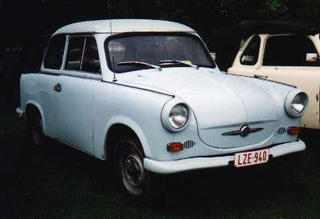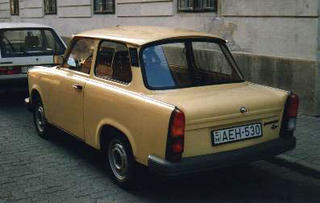




Ahhhh Trabant. Famous for it's smoke belching 2 stoke engines and Beetle rivalling longevity. And it's toy-like, plastic bodied fugliness. However, it has a cult following as it's easy to fix and can last for decades. But then so can lawn mowers.
Although many people familiar with the Trabant don't know it, Trabant is actually the model name. Sachsenring is the company that produces the Trabant.
The car we know as the Trabant was born in 1957. It was officially called the Trabant P50 (top pic) and featured a 500cc twin cylinder two stroke engine, which used forced air cooling like VW's Beetle. The car was built using an inner shell and floor pan made of steel. The engine, transmision, steering and front suspension were mounted on a detachable sub frame. The outer body panels were all made of Duraplast plastic. This resulted in a compact, simple, economical, car that could seat four adults. The P50 was available in saloon, estate, and van formats and volume production started in 1957. At this time the Trabant P50, the P70, and P240 were all in production at the Sachsenring factory alongside of trucks. The P60 came after, and it was basically the same car with a larger 600cc engine.
In 1964 the Trabant had a major redesign which resulted in the launch of the P601 - the car most know and love (second and third pics). This car retained the same basic concept, and the new body style provided more interior and luggage space, as well as the plain egg crate grille upfront. Particularly fugly examples had the grille, bumpers, and light surrounds painted black.
The P601 body style was the last major styling revision until the end of production in 1991. This lead many people to believe that the cars stayed the same and no further development took place. In reality the cars were constantly developed and every year saw the introduction of a number of changes. The power output of the engine gradually increased, and modifications to the engine allowed it to run with much less oil mixed with the petrol. The brakes were improved, and electrics upgrades were made. With the basic core staying the same, many older Trabants were carefully recycled by being rebuilt and updated with later components which ads to the car's longevity and easy of maintenance.
In 1988 an agreement was entered with VW to produce Polo engines which were fitted to a much modified version of the P601 usually refered to as the 1.1 (most visible was the new grille and taillights - bottom 2 pics). This was initially produced in parallel with the two stroke car. Eventually, after the fall of the Berlin wall the production of the two stroke car was phased out.

1 comment:
Very objective, to actually point out that there were upgrades done to the vehicle over time! I think most people just blew it off as a ghetto attempt to even BUILD a car. What with the way the economy and resources were over there at the time, they did all right, if you go ahead and factor in all the other circumstances! Still, they ARE homely little buggers, aren't they?
Post a Comment